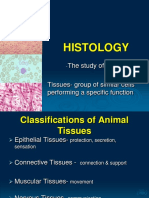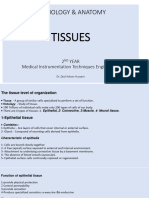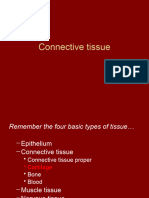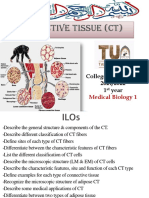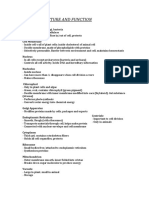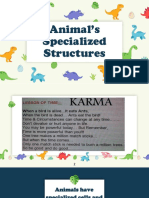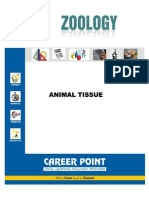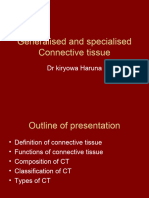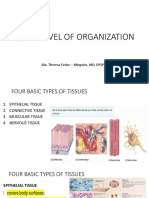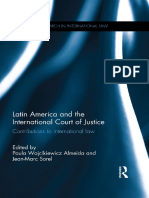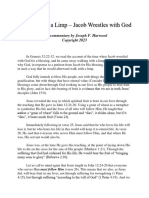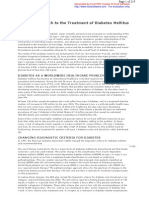0 ratings0% found this document useful (0 votes)
7 viewsHistology Unit Ii: Cells, Tissues, Bone and Cartilage Formation
Histology Unit Ii: Cells, Tissues, Bone and Cartilage Formation
Uploaded by
Janni FinucaneThis document provides an overview of histology topics including cells, tissues, bone and cartilage formation. It discusses the basic components and structures of cells, the four main tissue types (epithelial, connective, muscle and nerve), and provides more detailed information on epithelial tissue classifications, the basement membrane, muscle tissue organization, and the processes of chondrogenesis and cartilage formation.
Copyright:
Attribution Non-Commercial (BY-NC)
Available Formats
Download as PPT, PDF, TXT or read online from Scribd
Histology Unit Ii: Cells, Tissues, Bone and Cartilage Formation
Histology Unit Ii: Cells, Tissues, Bone and Cartilage Formation
Uploaded by
Janni Finucane0 ratings0% found this document useful (0 votes)
7 views45 pagesThis document provides an overview of histology topics including cells, tissues, bone and cartilage formation. It discusses the basic components and structures of cells, the four main tissue types (epithelial, connective, muscle and nerve), and provides more detailed information on epithelial tissue classifications, the basement membrane, muscle tissue organization, and the processes of chondrogenesis and cartilage formation.
Original Title
CELTIS
Copyright
© Attribution Non-Commercial (BY-NC)
Available Formats
PPT, PDF, TXT or read online from Scribd
Share this document
Did you find this document useful?
Is this content inappropriate?
This document provides an overview of histology topics including cells, tissues, bone and cartilage formation. It discusses the basic components and structures of cells, the four main tissue types (epithelial, connective, muscle and nerve), and provides more detailed information on epithelial tissue classifications, the basement membrane, muscle tissue organization, and the processes of chondrogenesis and cartilage formation.
Copyright:
Attribution Non-Commercial (BY-NC)
Available Formats
Download as PPT, PDF, TXT or read online from Scribd
Download as ppt, pdf, or txt
0 ratings0% found this document useful (0 votes)
7 views45 pagesHistology Unit Ii: Cells, Tissues, Bone and Cartilage Formation
Histology Unit Ii: Cells, Tissues, Bone and Cartilage Formation
Uploaded by
Janni FinucaneThis document provides an overview of histology topics including cells, tissues, bone and cartilage formation. It discusses the basic components and structures of cells, the four main tissue types (epithelial, connective, muscle and nerve), and provides more detailed information on epithelial tissue classifications, the basement membrane, muscle tissue organization, and the processes of chondrogenesis and cartilage formation.
Copyright:
Attribution Non-Commercial (BY-NC)
Available Formats
Download as PPT, PDF, TXT or read online from Scribd
Download as ppt, pdf, or txt
You are on page 1of 45
HISTOLOGY UNIT II
CELLS, TISSUES, BONE AND
CARTILAGE FORMATION
CELLS
Cells have 3 basic components:
– EXTRACELLULAR FLUID-tissue fluid & intercellular
substance
– CELL MEMBRANE
• phospholipid & protein bilayer
• receptors for biochemical products
– CYTOPLASM
• cytoskeleton for support
• organelles
• vacuoles & inclusions
CYTOPLASM
Consistency between liquid & gel
Cytoskeleton- 3 dimensional support
system made of
– microfilaments
– microtubules
– intermediate filaments
Centrioles-2/cell, important in cell division
CYTOPLASM CONTENTS
Organelles-membrane sacs perform cell
functions
– Nucleus-DNA & RNA, control center
– Mitochondria-energy/ATP
– Ribosomes-protein production
– Endoplastic Reticulum-protein modification
– Golgi Complex-p.modification & release
– Lysosomes-phagocytic enzymes
CELL JUNCTIONS
Mechanical connections between cells-
desmosomes; or between cells and
non-cellular surfaces-hemidesmosomes
(can anybody think of an example of
this? Find the answer in your reading)
Composed of attachment plaques and
tonofibrils
BASIC TISSUES
4 Types of tissues:
– Epithelial
– Connective
– Muscle
– Nerve
– Yes, you should remember the embryonic
derivation of each tissue type
TISSUE COMPONENTS
CELLS
EXTRACELLULAR MATRIX or
INTERCELLULAR SUBSTANCE
TISSUE FLUID
EPITHELIAL TISSUE
Embryonic origin: ectoderm, endoderm
Characteristics:
– sheets of cells
– little intercellular substance
– usually avascular
– cell junctions
– rapid regeneration
– contains other cell types
EPITHELIAL TISSUE
Functions:
– Protection
– Secretion
– Absorption
– Transport
– Lubrication
– Sensory Perception
– Excretion
Epithelial Tissue Classifications
Number of cell layers:
– Simple
– Stratified
– Psuedostratified
Cell shape:
– squamous
– cuboidal
– columnar
Epithelial Tissue Classifications
Specialization in the oral cavity:
– Keratinized-free & attached gingiva
(gingival tissue we can see)
– Non-keratinized-sulcular lining, buccal
mucosa, ventral surface of tongue, soft
palate
– Parakeratinized-hard palate
Most oral epi. is stratified squamous
BASEMENT MEMBRANE
Separates epi from ct
Supports, connects, barrier protection
Acellular, 2 layer:
– Basal layer/lamina (epi derived)
• lamina lucida
• lamina densa
– Reticular layer (ct derived)
MUSCLE TISSUE
Embryonic origin: mesoderm, somites
Characteristics:
– Mostly composed of cells
– Cells large & visible, called fibers
– Cells have multiple nuclei
– Protein filaments (actin & myosin) in
cytoplasm
– Cells held together by ct sheath/framework
Muscle Tissue Terminology
Cell membrane called SARCOLEMA
Cytoplasm called SARCOPLASM
Cells are called FIBERS
Fibers are made of MYOFIBERS
Myofibers are made of MYOFILAMENTS
Myofilaments are made of ACTIN &
MYOSIN
Muscle Tissue Organization-118
Each fiber covered by ct sheath-
ENDOMYSIUM
Fiber +Endomysium grouped into bundles
called FASICLES
Fasicles covered by ct sheath-
PERIMYSIUM
Fasicles+Perimysiumbundled together-
EPIMYSIUM; whole=MUSCLE
Role of CT Sheaths
Biomechanical:
– supports cells and holds cells together
– transmits contractions
– binds muscle to attachment
directly/indirectly
Physiologic:
– carries blood vessels and nerves
Types of Muscle Tissue
Smooth:
– involuntary
– associated with autonomic nervous system
– bv walls, lymphatics, skin, digestive system
Heart/Cardiac:
– involuntary
– striated
– Purkinje fibers
Types of Muscle Tissue
Skeletal/striated:
– Voluntary
– Movement/contraction called action,
initiated by motor nerves
– Attachments to skeleton
• Origin
• Insertion
• Intermediate attachments
Relationship to Nerves
Myoneural/neuromuscular junction
Neuron+Muscle cell=Motor Unit
Energy expenditure hi for skeletal
muscles
Contraction caused by actin and myosin
filaments sliding over each other
NERVE TISSUE
Embryonic Origin: ectoderm (neural
crest)
Organization:
– Cell body=Neuron/Perikaryon
– Dendrites=neural process that receive stimuli
– Axon=neural process that conducts stimuli away
from cell body
– Synapse=junction btwn neurons/ neurons+organ
NERVE TISSUE
Types of nerves:
– Afferent/sensory-carries info from
peripherey of body to brain
• taste, pain, proprioception
– Efferent/motor-carries info from brain to
peripherey of body
• muscle activation
Nervous System
Central Nervous System:
– Brain
– Spinal Cord
Peripheral Nervous System:
– Autonomic nervous system-efferent nerves
• Sympathetic
• Parasympathetic
CRANIAL NERVES
5th or TRIGEMINAL
7th or FACIAL
9th or GLOSSOPHARYNGEAL
12th or HYPOGLOSSAL
CONNECTIVE TISSUE
Embryonic origin: mesoderm,
mesenchyme
Characteristics:
– most diverse tissue type
– wide variety of cells
– may be loose, dense, fluid, rigid,
mineralized, non-mineralized
CONNECTIVE TISSUE
Significance to dental hygiene:
– Structures of the periodontium are ct (G-
has an epi covering, C, PDL, AVB)
– All tooth structures except enamel are ct
– Defense cells are ct cells (PMNs, monos,
macros, eosinophils, basophils)
– Immunocompetent cells are ct cells (B & T
lymphocytes, plasma cells)
Connective Tissue Functions
Structural support
Metabolic activities between blood,
tissues and cells
Defense:
– phagocytic cells
– immunocompetent cells
– cells with pharmacologic action
Classification of CT Types
Embryonic – Dense Regular-
– Mesenchyme tendons, ligaments
– Mucous ct – Adipose
Mature/CT Proper:
Specialized CT
– Loose- irregular- – Blood & Lymph
fascia underlying – Cartilage
epithelial lining tissue – Bone
– Dense Irregular-ct
capsules & dermis
Components of CT
3 components:
Ground substance
Fibers
Cells
Components of CT-Ground Sub.
Intercellular ground substance-forms the
matrix for other 2 components
– consistency varies-fluid to gel
– made of proteoglycans (PG) which help
regulate collagen fiber formation & chemically
linked to glycosaminoglycans (GAGs)
– functions of ground substance:
• electrolyte balance
• prevent spread of foreign matter & pathogens
CT-GAGs
Hyaluronic acid
Chondroitin 4 sulfate
Chondroitin 6 sulfate
Dermatan sulfate
Keratan sulfate
Heparan sulfate & heparin
*all can act as histochemical markers for oral
health or disease-why??
Components of CT-Fibers
Fibers (formed by fibroblasts):
– Reticular
– Collagen-significant to dh; predominant
fiber in the periodontium, made of proteins
(tropocollagens)
– Elastic
Fibers imbedded in Ground Substance
= Extracellular Matrix
CT Fibers & the Periodontium
Collagen fibers are found in
– gingiva-fibers are arranged in bundles & help
adapt tissue to tooth surface & connect tissue to the
periosteum
– periodontal ligament-fibers are arranged in
groups, ends of fibers are embedded in cementum
and in the AVB (Sharpey’s fibers)
– cementum-fibers are embedded in the calcified
matrix of this tooth layer
– AVB-form major part of bone matrix
Components of CT-Cells
Cells-wide variety of cell types are found
in CT
All ct cells are derived from stem cells;
these are undifferentiated cells capable of
specialization
2 forms of stem cells:
– undifferentiated mesenchymal cell
– hematopoietic stem cell
Cells formed by mesenchymal
stem cells
Fibroblast-forms fibers *collagen synthesis
Adipocyte
Chondroblast-cartilage former; chondrocyte
Osteoblast-bone former, collagen former in
mineralized tissues; osteocyte
Mesothelial cell
Endothelial cell
Cells formed by hematopoietic
stem cells
Mast cell-contain biochemical mediators
Red blood cells/Erythrocytes
Platelets
White blood cells/Leukocytyes:
– PMNs/neutrophils
– Lymphocytes-Ts, Bs, plasma cells
– Monocytes-macrophages
• osteoclasts *not a WBC but is a phagocytic cell
– Eosinophils
– Basophils
Specialized connective tissues
Cartilage:
– Rigid
– Non-mineralized
Bone:
– Rigid
– Mineralized
CHONDROGENESIS
Cartilage characteristics:
– Avascular
– No nerve supply
– 75% intercellular ground substance
– Rapid growth in low O2 environment
– Embryonic skeleton
– Model for adult skeleton
Cartilage formation
Mesenchymal cells differentiate into
chondroblasts
Chondroblasts secrete matrix
– Matrix = Fibers + Ground Substance
Matrix surrounds & traps cblasts in lacunae
Matrix + trapped cell = chondrocyte
Appositional & interstitial growth
Cartilage Structure
Cartilage (cells trapped in matrix)
surrounded by
Perichondrium:
– dense fibrous ct
– composed of fibroblasts
– contains mesenchymal cells (potential cblasts)
– contains blood vessels
– site of muscle attachments, gives shape
Types of cartilage
Hyaline Fibrocartilage
– resists compression – no perichondrium
– movement @ joints – compression &
– fetal skeleton, tension
articular surfaces, – hi collagen content
costal cartilage – intervertebral discs,
Elastic pubic symphysis,
– stiff but flexible tendon attachments
– ears, epiglottis, larynx
OSTEOGENESIS
Bone characteristics:
– Specialized rigid mineralized tissue
• 50% organic-cells, intercellular substance (collagen
fibers + ground substance = osteoid matrix)
• 50% inorganic-hydroxyapatite salts
– Organ-skeleton
• support & protection
• hemopoetic tissue
• calcium & phosphorus ion reservoir
Bone Formation
Mesenchymal cells differentiate to form
osteoblasts
Osteoblasts secrete matrix
– Matix = Fibers + Ground Substance
Matrix surrounds & traps oblast in lacunae
Matrix + trapped cell = osteocyte
Constant apposition & resorption
Bone Cells & Functions
Progenitor cells Osteoclasts
– undifferentiated stem – resorption
cell population – multinucleated giant
Osteoblasts cell
– secrete matrix – phagocytosis of
– deposit inorganic salts matrix & salts
– formation/resorption Bone lining cells
Osteocytes – line bone surface
– mature oblast – ion exchange
BONE STRUCTURE
Periosteum-outer ct membrane layer,
contains progenitor cells
Compact bone-solid, layered, Haversian
systems
Endosteum-inner ct membrane layer,
contains progenitor cells
Spongy/trabecular bone-thin layers of
bony plates with spaces
CLASSIFICATION OF BONE
TEXTURE: HISTOLOGIC
– Compact ORGANIZATION:
– Cancellous/spongy – Woven/reticular
• immature
DEVELOPMENT:
• low collagen &
– Intramembraneous minerals
• directly from
– Lamellar
mesenchymal cells
• mature
– Endochondrial • layers
• cartilage model
• highly mineralized
You might also like
- Wyckoff 2.0, Cau Truc, Ho So Khoi Luong Va Dong Lenh - 0001Document256 pagesWyckoff 2.0, Cau Truc, Ho So Khoi Luong Va Dong Lenh - 0001hmquan.tkNo ratings yet
- Court Documents Reveal Kayla Montgomery Identified Her Husband As Killer of Young Harmony MontgomeryDocument7 pagesCourt Documents Reveal Kayla Montgomery Identified Her Husband As Killer of Young Harmony MontgomeryBoston 25 Staff100% (2)
- Anatomy Notes Week3Document18 pagesAnatomy Notes Week3Zainab Ali100% (3)
- Histology: The Study of TissuesDocument37 pagesHistology: The Study of TissuesHans Even Dela Cruz100% (1)
- 7 TissuesDocument111 pages7 TissuesMaria Angelica AlmendrasNo ratings yet
- Eng Anatomy Nomenclature OrientaDocument55 pagesEng Anatomy Nomenclature OrientaOrNo ratings yet
- Histology: The Study of TissuesDocument39 pagesHistology: The Study of TissuesEla Santos100% (1)
- Chapter 1 Intro To The Human Body 08/30/2010Document55 pagesChapter 1 Intro To The Human Body 08/30/2010Betsy Jane CarterNo ratings yet
- Anatomy LabDocument249 pagesAnatomy Lablifenoras19No ratings yet
- Tissues (Nursing)Document52 pagesTissues (Nursing)elkanachitwaNo ratings yet
- التشريح والفسلجة نظريDocument16 pagesالتشريح والفسلجة نظريem2200139No ratings yet
- First Shifting Practical #2Document6 pagesFirst Shifting Practical #2Kaela Lizado0% (1)
- Tissue-Level-of-OrganizationDocument5 pagesTissue-Level-of-OrganizationmaazjunnedijNo ratings yet
- BI102 - 106 Lecture - Animal Tiss 2023Document53 pagesBI102 - 106 Lecture - Animal Tiss 2023HeartNo ratings yet
- Connective TissueDocument51 pagesConnective TissueYIKI ISAACNo ratings yet
- Histology: The Study of Cells and TissuesDocument24 pagesHistology: The Study of Cells and TissuesMohammedHajNo ratings yet
- Biosci Lab Connective TissuesDocument3 pagesBiosci Lab Connective TissuesErine Abrenica LantinNo ratings yet
- Connective Tissue Histology: Ma. Minda Luz Meneses-Manuguid, M.DDocument28 pagesConnective Tissue Histology: Ma. Minda Luz Meneses-Manuguid, M.Dchocoholic potchiNo ratings yet
- HistologyDocument6 pagesHistologyveerdoriNo ratings yet
- Vet Histo Notes Chap 3Document15 pagesVet Histo Notes Chap 3Mia Kristhyn Calinawagan SabanalNo ratings yet
- Connective Tissue (CT)Document37 pagesConnective Tissue (CT)Fady FadyNo ratings yet
- CT nd APDocument18 pagesCT nd APcasanovamike23No ratings yet
- 5 Connective Tissue 1Document40 pages5 Connective Tissue 1miladsherwanyNo ratings yet
- Basic Histo Plus INTEGUMEN For MidwifeDocument107 pagesBasic Histo Plus INTEGUMEN For MidwifeAuliya ShintaNo ratings yet
- 2.1 BM I Matrix ExtracelDocument48 pages2.1 BM I Matrix ExtracelDanti FadhilaNo ratings yet
- Cell Structure and FunctionDocument13 pagesCell Structure and FunctionNatalie KwokNo ratings yet
- 1.1 - Tissues. Epithelial, Connective, Muscle, Nerve, Blood, ReproductiveDocument4 pages1.1 - Tissues. Epithelial, Connective, Muscle, Nerve, Blood, ReproductiveAris PaparisNo ratings yet
- Gen Bio Cell TypesDocument27 pagesGen Bio Cell TypesJonaya AmpasoNo ratings yet
- Anaphy TissuesDocument4 pagesAnaphy TissuesYo1No ratings yet
- Connective Tissue II by SBRDocument40 pagesConnective Tissue II by SBRarthurrkingsmanNo ratings yet
- open cheykuDocument37 pagesopen cheykuakancharlapalliNo ratings yet
- 1.1 Animal's Specialized StructuresDocument58 pages1.1 Animal's Specialized StructuresNathaliabee100% (1)
- Histologi 1Document47 pagesHistologi 1Wndy 0903No ratings yet
- Connective Tissue Lecture 1Document25 pagesConnective Tissue Lecture 1علي المحترف100% (1)
- Histology & Its Method To StudyDocument65 pagesHistology & Its Method To StudyPuspa YaNi100% (1)
- Connective TissueDocument65 pagesConnective Tissuesmcm11No ratings yet
- Where Does The Glycolysis OccourDocument2 pagesWhere Does The Glycolysis OccourMaria Claudette Andres AggasidNo ratings yet
- CT - 5 - PDF - 231016 - 094643Document38 pagesCT - 5 - PDF - 231016 - 094643Achraf RabadiNo ratings yet
- General Histology: DR Samina ShaheenDocument104 pagesGeneral Histology: DR Samina ShaheenJemarey de RamaNo ratings yet
- HISTOLOGY Connective Tissue (Components)Document16 pagesHISTOLOGY Connective Tissue (Components)faariyaabdullah03No ratings yet
- Cartilage & Bone '07Document44 pagesCartilage & Bone '07ade ayuningsih utamiNo ratings yet
- Zoology Animal TissueDocument54 pagesZoology Animal TissueasuhassNo ratings yet
- Chapter 1 - 2013 Animal TissuesDocument8 pagesChapter 1 - 2013 Animal TissuesSiti Juwairiah ZainurinNo ratings yet
- Biology ProjectDocument15 pagesBiology ProjecttanNo ratings yet
- Connective TissueDocument49 pagesConnective TissuePaapa MorrisNo ratings yet
- Zoo MidDocument6 pagesZoo MidRochelle San DiegoNo ratings yet
- Zoo101 (Lec) Assignment - Cell Growth and ReproductionDocument11 pagesZoo101 (Lec) Assignment - Cell Growth and ReproductionJanaCasandra ManitiNo ratings yet
- Epithelial TissueDocument57 pagesEpithelial TissuePreet Kaur100% (1)
- 11 Biology Revision Study Material Chapter 7Document10 pages11 Biology Revision Study Material Chapter 7Saurav Soni100% (1)
- 2.4 HistologyDocument41 pages2.4 Histologyhaiqalfariq07No ratings yet
- Connective TissueDocument91 pagesConnective TissueSamuel ArikodNo ratings yet
- 4.1 - Tissue Level of OrganizationDocument94 pages4.1 - Tissue Level of OrganizationEmman ImbuidoNo ratings yet
- Concept Map For Animal CellDocument5 pagesConcept Map For Animal CellJennifer Pangilinan67% (3)
- Animal TissuesDocument35 pagesAnimal TissuesAllen ZafraNo ratings yet
- Lesson 1 Plant and Animal Tissue Presentation1Document60 pagesLesson 1 Plant and Animal Tissue Presentation1abdullahfahdelm.adiongNo ratings yet
- Connective TissueDocument202 pagesConnective TissuePeter ThompsonNo ratings yet
- CH 2: The Cell: GoalsDocument38 pagesCH 2: The Cell: GoalsHitansh KotadiyaNo ratings yet
- Cell Types and Tissues of HumansDocument23 pagesCell Types and Tissues of HumansgcodouganNo ratings yet
- REV Micro HSB RemedsDocument16 pagesREV Micro HSB RemedsPatricia HariramaniNo ratings yet
- Anaphy NotesDocument2 pagesAnaphy NotesKadunan FreitasNo ratings yet
- General Biology R Q3Document16 pagesGeneral Biology R Q3Maysheil GalarceNo ratings yet
- Lesson 3. Positive Use of Information and Communications TechnologyDocument7 pagesLesson 3. Positive Use of Information and Communications TechnologyJona Mae Degala DordasNo ratings yet
- Reddit R Fitness Pro-HAES CensorshipDocument96 pagesReddit R Fitness Pro-HAES CensorshipMindfuzzedNo ratings yet
- Capitol Medical Center, Inc. vs. Trajano, 462 SCRA 457, June 30, 2005Document9 pagesCapitol Medical Center, Inc. vs. Trajano, 462 SCRA 457, June 30, 2005Mark ReyesNo ratings yet
- Scrum Training: by Abderrahmen MokraniDocument71 pagesScrum Training: by Abderrahmen MokraniAbderrahmen MokraniNo ratings yet
- Mahayana SutrasDocument8 pagesMahayana SutrasnieotyagiNo ratings yet
- Mutual Cooperation Based Go Green: New Concept of Defense CountryDocument8 pagesMutual Cooperation Based Go Green: New Concept of Defense CountryjagadNo ratings yet
- Reviewer in English 10Document2 pagesReviewer in English 10EdLoi TangguiyacNo ratings yet
- (Routledge Research in International Law.) Almeida, Paula Wojcikiewicz - Sorel, Jean-Marc - Latin America and The International Court of Justice - Contributions To International Law-Routledge (2017)Document349 pages(Routledge Research in International Law.) Almeida, Paula Wojcikiewicz - Sorel, Jean-Marc - Latin America and The International Court of Justice - Contributions To International Law-Routledge (2017)Viviana HurtadoNo ratings yet
- Math Free Iq TestDocument2 pagesMath Free Iq TestChengLu PuaNo ratings yet
- Mission and Ministry of PaulDocument24 pagesMission and Ministry of PaulSarath Santhosh RajNo ratings yet
- Theory of Architecture ImportanceDocument2 pagesTheory of Architecture Importancelugasalo4996No ratings yet
- Position PaperDocument2 pagesPosition PaperEdmar TeezyNo ratings yet
- Țile Și Importan Ța Temei Abordate - Introducerea Nu Se Numerotează Ca Şi CapitolDocument12 pagesȚile Și Importan Ța Temei Abordate - Introducerea Nu Se Numerotează Ca Şi CapitolMark BellNo ratings yet
- HR Procedure Manual - Team-HrDocument24 pagesHR Procedure Manual - Team-HrBharattWinner100% (2)
- To Walk With A Limp - Jacob Wrestles With GodDocument3 pagesTo Walk With A Limp - Jacob Wrestles With Godmollyopiyo4No ratings yet
- Topic 3 ExamplesDocument9 pagesTopic 3 ExamplesJessica MccormickNo ratings yet
- Ice Breaking ActivitiesDocument6 pagesIce Breaking ActivitiesZainab ZuliatyNo ratings yet
- Method of ProofDocument14 pagesMethod of ProofChai Jin YingNo ratings yet
- Thi Qar Arts Journal: Vol 34 No.1 Jan. 2021Document19 pagesThi Qar Arts Journal: Vol 34 No.1 Jan. 2021Mu'izzudinNo ratings yet
- Course Syllabus MLAB 1227-CoagulationDocument8 pagesCourse Syllabus MLAB 1227-Coagulationlubna aloshibiNo ratings yet
- Assignment 1Document4 pagesAssignment 1vardhiniNo ratings yet
- Joist SlabDocument13 pagesJoist SlabAhmed Nabil83% (6)
- Key Facts and Figures On Gender Based ViolenceDocument26 pagesKey Facts and Figures On Gender Based Violenceanon_787479624100% (1)
- Health Assessment QuestionnaireDocument3 pagesHealth Assessment QuestionnaireAshoka1988No ratings yet
- Bài tập 1Document7 pagesBài tập 1Hào PhạmNo ratings yet
- HealthDocument319 pagesHealthpredic1No ratings yet
- Wellerism Proverbs: Mapping Their DistributionDocument35 pagesWellerism Proverbs: Mapping Their DistributionDrinkmorekaariNo ratings yet
- NAME: - FORM: 3 - Caribbean History Coursework # 1 (25%) DATEDocument2 pagesNAME: - FORM: 3 - Caribbean History Coursework # 1 (25%) DATEmarlonNo ratings yet






